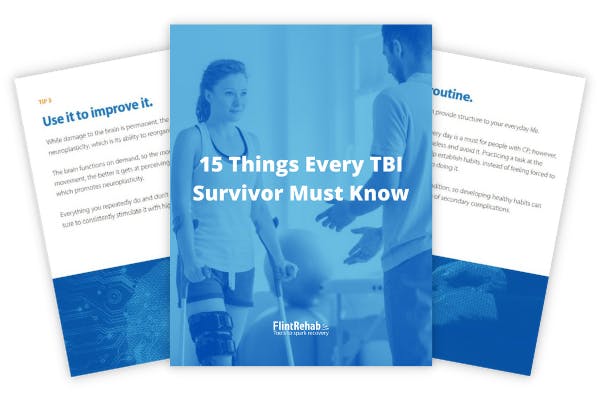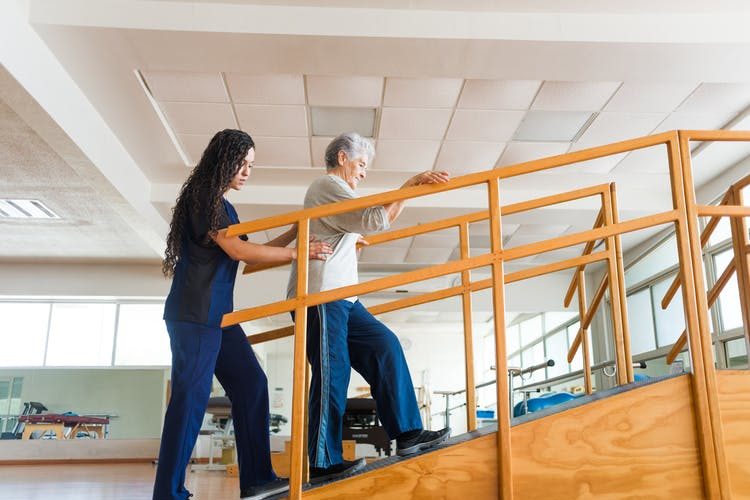A Step-By-Step Guide to Walking After Brain Injury: Exercises & Rehabilitation Methods
Walking after brain injury is a common recovery goal during physical therapy. Many traumatic brain injury survivors are eager to improve their gait, or manner of walking, to regain independence and feel confident with the activities of daily living again.
To help you regain the ability to walk on your own, this guide will explain some of the challenges when learning to walk again after a traumatic brain injury (TBI) along with the steps you can take to improve your gait.
Why Can a Brain Injury Affect Walking Skills?
There are several reasons why a brain injury can affect a person’s gait, or ability to walk. Some common causes of gait changes include:
- Balance problems. Between 30% and 65% of traumatic brain injury survivors struggle with balance issues. These can stem from a range of issues including muscle weakness, inner ear damage, and damage to the cerebellum, which plays a role in maintaining balance.
- Primary motor cortex damage. The primary motor cortex is also responsible for the coordination of muscle movements. If a brain injury damages this area, then activities that involve multiple muscle groups, like walking, can become impaired.
- Spasticity. When a brain injury disrupts the connection between the brain and the muscles, the brain can no longer send signals to the muscles telling them when to contract. As a result, spasticity and muscle tightness can set in, making walking after brain injury much more difficult.
With such a variety of different causes of poor gait after brain injury, it’s important for brain injury survivors to work closely with their therapists to diagnose and rehabilitate their walking abilities.
How Can I Train My Brain to Walk Again?
Walking after brain injury involves retraining the brain to control the muscles involved in walking. This is possible thanks to neuroplasticity.
Neuroplasticity is the brain’s ability to rewire and reorganize itself. After a brain injury, neuroplasticity allows the brain to compensate for the damage. Although damaged brain cells cannot regenerate, neuroplasticity allows healthy areas of the brain to take on impaired functions.
For instance, if a brain injury affected the cerebellum, the function of balance can become impaired. Through neuroplasticity, the function of balance can be rewired to healthy areas of the brain. It does not happen on its own, though.
Neuroplasticity occurs through repetition and consistency. The brain likes to be efficient, so it will create and strengthen neural pathways for activities that are practiced regularly.
During gait rehabilitation after TBI, survivors practice therapeutic movements involved in walking. Depending on the problem area, the individual may practice leg or balance exercises. When these exercises are practiced with high repetition, it stimulates neuroplasticity and encourages the brain to improve efficiency of those movements.
To put it simply, an individual with brain injury can train their brain to walk again through repetitive practice of gait rehabilitation exercises.
Rehab Exercises to Walk Again After Brain Injury
Rehab exercises are a critical step towards regaining the ability to walk. It’s important to work with your therapists to create a custom rehabilitation regimen that caters to your unique needs.
Up next, we will discuss some common rehabilitation techniques that your therapist may suggest.
1. Passive Rehab Exercises
Individuals that have experienced a severe brain injury may have no movement in their legs and therefore cannot walk. This often means they rely on wheelchairs to get around instead of other less-restricting devices like a cane.
Fortunately, it is still possible to regain muscle movement and walking skills even if you have limited leg function. You can do this through passive exercise, which involves assisting your legs through targeted movements, rather than moving with your legs’ muscle power alone.
Passive exercise helps stimulate the brain and activate neuroplasticity, particularly when attention is paid to the movement. Focusing on and mentally visualizing the body completing a movement increases associated brain activation, optimizing neuroplasticity.
A therapist or trained caregiver can help a TBI survivor accomplish these passive exercises that target the legs, or the survivor may learn how to complete the exercises independently using their upper body to assist.
Passive techniques are a great place to begin learning how to walk again after brain injury. With time and practice, individuals may slowly regain movement in the legs; at which point they can move onto active exercises.
2. Leg Exercises
Perhaps the most obvious rehab exercises to walk again after brain injury are exercises that target movement and strength of the legs. Walking is a full-body activity, and the legs play a large role.
Practicing rehab exercises that target the legs will help retrain the brain to use the legs with increasing coordination. As movements become more coordinated, individuals can also focus on strengthening the legs through exercise.
Some examples of leg exercises for gait rehabilitation include:
- Seated marching. Start in a seated position. Lift your affected leg up toward your chest, hold for one second, then slowly let it down. Repeat on the other leg. If this is too difficult, you can do this exercise passively by using your arms to assist your legs.
- Knee extension. Sit on a stool or chair. Next, extend your knee as far out as you can. Then slowly bring your foot to the floor. Repeat on the other leg.
Although some leg exercises may seem to be only addressing movement, it is important to remember that you can build strength by lifting only your own body weight, rather than always having to rely on additional weights.
As with all rehab exercise, high repetition and consistency are key to rewiring the brain and improving movement after brain injury.
3. Foot Drop Exercises


Keep it going: Do you know these 15 essential TBI recovery tips?

If you like our content, you’ll love our ebook and newsletters! Get instant access to our TBI recovery tips ebook with 20 pages of helpful advice by signing up below.
You’ll also receive our emails that share survivor stories and more useful TBI recovery tips, which you can opt out of at any time. (We know you’ll love them, too.)
We will never sell your email address, and we never spam. That we promise.
